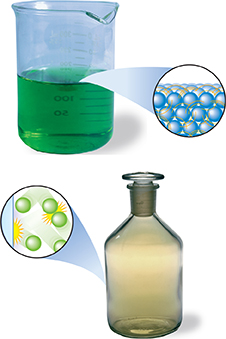The pencil point has a much smaller area than the eraser, so it exerts much greater pressure than the eraser. The greater pressure exerted by the pencil point allows it to pierce the paper easily.
 To calculate pressure, divide the force by the area over which the force acts.
To calculate pressure, divide the force by the area over which the force acts.

In the formula, force should be in newtons (N) and area should be in square meters (m2). The resulting unit, newtons per square meter (N/m2), is the SI unit of pressure, also known as a pascal(Pa). The pascal is named for French scientist Blaise Pascal (1623–1662). Pressures are often stated in units of kilopascals (kPa). Note that 1 kPa is 1000 Pa.
Consider a box with a weight of 2700 newtons resting on the ground. If the area of the box touching the ground is 1.5 square meters, what pressure does the box exert on the ground?
Figure 2 Both liquids and gases can flow and take on the shape of their containers. AParticles in a liquid are tightly packed together but are able to slide past one another. BParticles in a gas are far apart and travel in straight lines until they collide with another particle or object.
Inferring Based on the illustrations, can a gas be compressed into a smaller space?

Pressure in Fluids
A fluid is a substance that assumes the shape of its container. Both liquids and gases are fluids. Water, oil, gasoline, air, and helium are fluids. The particles that make up liquids and gases are shown in Figure 2.
Just as a person sitting in a seat exerts force and pressure, so does a fluid. Imagine a glass filled with water. The water flows to take the same shape as that of the glass. Because the water is in contact with the walls and bottom of the glass, it exerts pressure on these surfaces. The amount of pressure exerted depends on several factors.
Have you ever noticed what happens to the pressure exerted on your body as you swim downward in a pool?
 Water pressure increases as depth increases. The pressure in a fluid at any given depth is constant, and it is exerted equally in all directions. Surprisingly, the shape of a container and the area of its bottom surface do not affect fluid pressure. For a fluid that is not moving, depth and the type of fluid are the two factors that determine the pressure the fluid exerts.
Water pressure increases as depth increases. The pressure in a fluid at any given depth is constant, and it is exerted equally in all directions. Surprisingly, the shape of a container and the area of its bottom surface do not affect fluid pressure. For a fluid that is not moving, depth and the type of fluid are the two factors that determine the pressure the fluid exerts.

How is fluid pressure related to fluid depth?




